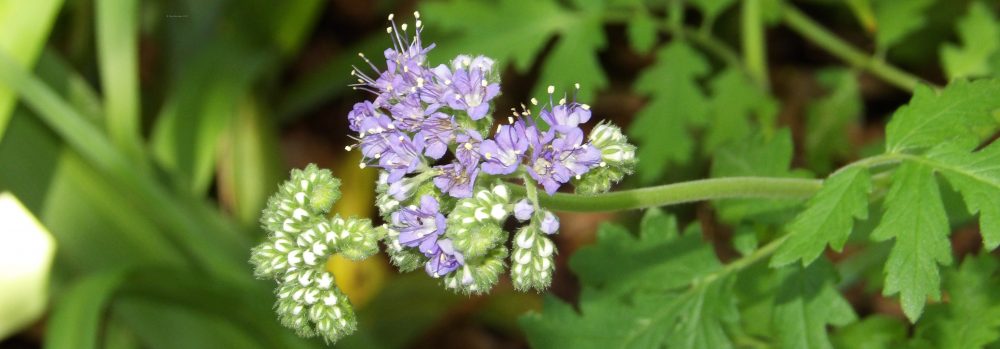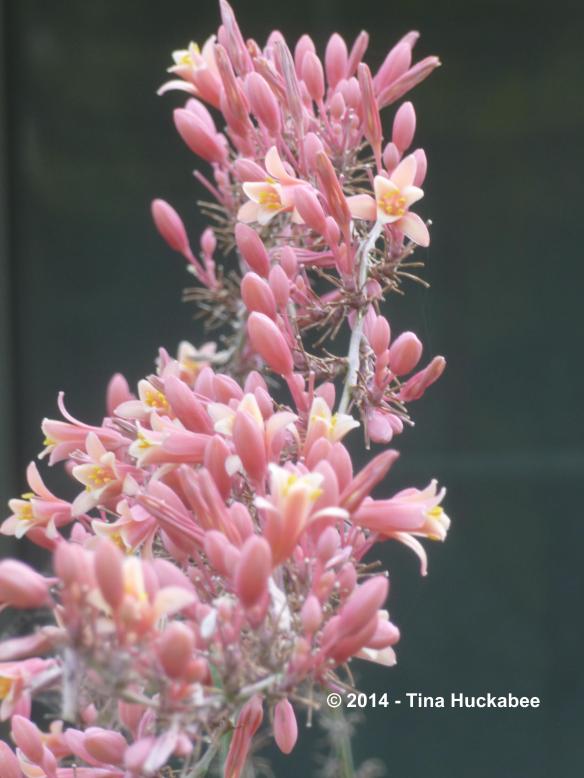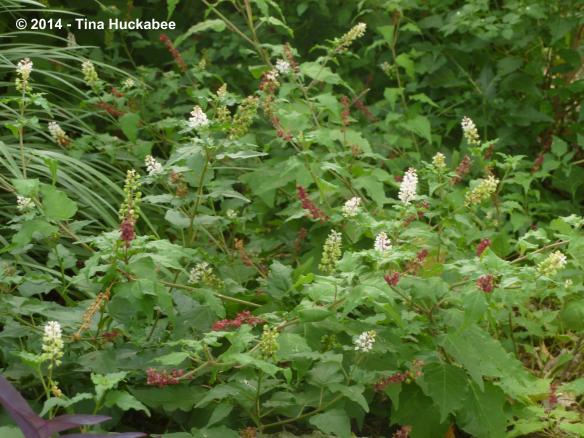Given the seemingly intractable problems our world faces, sometimes it’s hard for me to take garden blogging seriously. But encouraging beauty and sustainability through practical gardening choices is one ingredient toward healing a troubled world–even if it’s only on the trifling scale of our own back yards. Celebrating native plants and wildflowers, I’m joining with Gail at clay and limestone for July’s Wildflower Wednesday. Native plants and wildflowers provide year-round pleasure and sustenance–for gardeners and wildlife. There are so many reasons to use wildflowers in the home garden: they are beautiful, they require little irrigation and no chemicals and wildflowers evoke a sense of regional location. Using wildflowers in the home garden is one way to honor the natural, local beauty inherent in all places and to affirm a positive future, wherever one lives and grows.
In my gardens, Frostweed, Verbesina virginica, is just beginning its bloom period. I captured the very first tiny florets recently.
The flowers will expand in summer and early fall, then form into attractive seed heads. A mature Frostweed is multi-trunked,
and tall. This deciduous plant fits nicely into a shade or part shade garden.
One of this year’s first Goldeneye, Viguiera dentata, flowers was hiding behind some large leaves.
Another primarily fall bloomer, this happy native will burst forth with masses of blooms in October, so Texas-bright that you’ll almost need sunglasses to look at them! For now, the perennial sunflower is growing and producing a smattering of blooms.
The Red Yucca, Hesperaloe parviflora, is common in Central Texas. The clusters of pink-to-coral blooms,
are favored by hummingbirds, bees and people. Red Yucca is quite dramatic when viewed in its full form.
The tall, arching branches hold aloft those bloom clusters high above other perennials.
Closer to the ground, Pigeonberry, Rivina humilis, is a low-growing ground-cover that is beautiful and cooling in shade.
It produces many small, pink flower spikes which form luscious red berries which grateful birds enjoy.
In my gardens, a variety of doves snack on these berries.
Another strong hummingbird attractor is the Flame Acanthus, Anisacanthus quadrifidus var. wrightii. A deciduous shrub, the Fame Acanthus grows red-to-orange tubular flowers.
These striking blossoms bloom profusely during the summer and fall months and without efforts from this gardener.
That’s my kind of wildflower plant!
Here it is in full shrub mode, photo-bombed by a hardy Turk’s Cap!
There are many native Ruellia Texas. The one I grow is called Drummond’s Wild Petunia or Ruellia drummondiana and is another wildflower at the start of its summer/fall bloom cycle. A very tough plant which doesn’t require work from me, it displays small, purple blooms. Fresh blooms open each morning, then drop at the end of the day.
A versatile perennial, it performs well in either shade or sun and isn’t large. Ruellia dies to the ground in the winter, so I like to plant it between evergreens, like this group which is sandwiched between native Columbine on its left and native Yarrow to its right.
To me, Turk’s Cap, Malvaviscus arboreus, is the quintessential Texas wildflower. Thriving in the hottest and toughest conditions, it blooms, blooms, blooms.
It provides all sorts of good things for wildlife: cover, nectar, pollen and fruit. What’s not to love about that plant for Texas birds, bees and butterflies? And for two-legged Texans, Turk’s Cap form lovely perennial shrubs for their gardens that are easily maintained and make the statement: I’m from here!
Beauty matters.
Wildflowers matter.
Grow what belongs where you are: for ease, for wildlife, and because wildflowers work in the garden–in all sorts of ways.
Grow wildflowers because they give joy. And joy matters.

















All good choices for a very Texas Wildflower Wednesday. I have most of those happily growing in my garden as well. I recently discovered a little band of Ruellia drummondii growing wild and I’ll be back when they go to seed. Frostweed is a “must-add” also and I need to remember to get one on my next trip to a native plant nursery.
LikeLike
“drummondiana”!
LikeLike
They are all great choices for our area. Of course, I know you’d get that! But, I’m still befuddled as to why so many homeowners continue to use sterile, water-hog plants in their gardens and ignore interesting and valuable natives. I live in a neighborhood with almost no gardeners, so I’m considered a little odd for my landscape choices, No doubt, I’m considered a little odd for other reasons as well. 🙂
LikeLike
Great post – great photos – great points. Andy Warhol said “I think having land and not ruining it is the most beautiful art that anybody could ever want.” To my mind, using native wildflowers is in large part what “not ruining it” looks like and lives like in any successful garden.
My yard is most definitely different than the surrounding homes but I like to think I’m making it a little bit easier for any who are interested to ease away from their maintenance monster lawns.
LikeLike
When I began my “yard” transformation, I hoped that neighbors would see that having perennials/shrubs/flowers/ornamental grasses was more interesting than plain old grass. I hoped that they might notice that I didn’t seem to water much. Unfortunately, that hasn’t happened. I know it happens in other places, but not in my corner of the world. I’m dismayed when I see neighbors lose grass to drought conditions, then replace that grass–usually with the same kind of grass. Maybe it is just my neighborhood, but it’s discouraging that the average Jane and Joe still don’t understand that replacing grass with native plants has so many positive outcomes. Sigh. Like you though, I do hope that someone, somewhere will see what “we” gardeners do and follow in our footsteps.
LikeLike